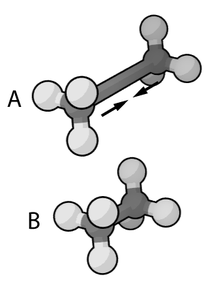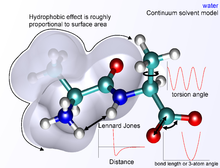Molecular mechanics

Molecular mechanics uses Newtonian mechanics to model molecular systems. The potential energy of all systems in molecular mechanics is calculated using force fields. Molecular mechanics can be used to study small molecules as well as large biological systems or material assemblies with many thousands to millions of atoms.
All-atomistic molecular mechanics methods have the following properties:
- Each atom is simulated as a single particle
- Each particle is assigned a radius (typically the van der Waals radius), polarizability, and a constant net charge (generally derived from quantum calculations and/or experiment)
- Bonded interactions are treated as "springs" with an equilibrium distance equal to the experimental or calculated bond length
Variations on this theme are possible; for example, many simulations have historically used a "united-atom" representation in which methyl and methylene groups were represented as a single particle, and large protein systems are commonly simulated using a "bead" model that assigns two to four particles per amino acid.
Functional form

The following functional abstraction, known as a potential function or force field in Chemistry, calculates the molecular system's potential energy (E) in a given conformation as a sum of individual energy terms.
where the components of the covalent and noncovalent contributions are given by the following summations:
The exact functional form of the potential function, or force field, depends on the particular simulation program being used. Generally the bond and angle terms are modeled as harmonic potentials centered around equilibrium bond-length values derived from experiment or theoretical calculations of electronic structure performed with software which does ab-initio type calculations such as Gaussian. For accurate reproduction of vibrational spectra, the Morse potential can be used instead, at computational cost. The dihedral or torsional terms typically have multiple minima and thus cannot be modeled as harmonic oscillators, though their specific functional form varies with the implementation. This class of terms may include "improper" dihedral terms, which function as correction factors for out-of-plane deviations (for example, they can be used to keep benzene rings planar).
The non-bonded terms are much more computationally costly to calculate in full, since a typical atom is bonded to only a few of its neighbors, but interacts with every other atom in the molecule. Fortunately the van der Waals term falls off rapidly – it is typically modeled using a "6–12 Lennard-Jones potential", which means that attractive forces fall off with distance as r−6 and repulsive forces as r−12, where r represents the distance between two atoms. The repulsive part r−12 is however unphysical, because repulsion increases exponentially. Description of van der Waals forces by the Lennard-Jones 6–12 potential introduces inaccuracies, which become significant at short distances.[1] Generally a cutoff radius is used to speed up the calculation so that atom pairs whose distances are greater than the cutoff have a van der Waals interaction energy of zero.
The electrostatic terms are notoriously difficult to calculate well because they do not fall off rapidly with distance, and long-range electrostatic interactions are often important features of the system under study (especially for proteins). The Quantized Valence Bonds' Molecular Mechanics (QVBMM) force field (implemented in Exorga, Incorporated's StruMM3D product, once named STR3DI32) is unique in molecular mechanics as the only one to directly use all lone pair interactions in all of its energy calculations. [2] The basic functional form is the Coulomb potential, which only falls off as r−1. A variety of methods are used to address this problem, the simplest being a cutoff radius similar to that used for the van der Waals terms. However, this introduces a sharp discontinuity between atoms inside and atoms outside the radius. Switching or scaling functions that modulate the apparent electrostatic energy are somewhat more accurate methods that multiply the calculated energy by a smoothly varying scaling factor from 0 to 1 at the outer and inner cutoff radii. Other more sophisticated but computationally intensive methods are known as particle mesh Ewald (PME) and the multipole algorithm.
In addition to the functional form of each energy term, a useful energy function must be assigned parameters for force constants, van der Waals multipliers, and other constant terms. These terms, together with the equilibrium bond, angle, and dihedral values, partial charge values, atomic masses and radii, and energy function definitions, are collectively known as a force field. Parameterization is typically done through agreement with experimental values and theoretical calculations results.
Each force field is parameterized to be internally consistent, but the parameters are generally not transferable from one force field to another. For example, the MM3 force field has 46 sets of parameters for oxygen and 18 sets for carbon (in different functional groups). MM3 has no parameters for lone pairs of electrons. On the other hand, the molecular recognition features of StruMM3D (which inputs only molecule's atom types and their coordinates) enables it to use only two parameters for each hybridization type of each atom (covalent radius and electronegativity), and it is parameterized for actively using lone pairs of electrons in its calculations. These molecular recognition features of StruMM3D allow for an easy usage of data from MM3 files. However, starting with the simple Cartesian coordinate data, as for example from a diffraction study, one would require considerable effort to produce a MM3 file. Most molecular modelers, and StruMM3D, can generate MM2, XYZ, and other files which can be read by MM3.
Areas of application
The prototypical molecular mechanics application is energy minimization. That is, the force field is used as an optimization criterion and the (local) minimum searched by an appropriate algorithm (e.g. steepest descent). Global energy optimization can be accomplished using simulated annealing, the Metropolis algorithm and other Monte Carlo methods, or using different deterministic methods of discrete or continuous optimization. The main aim of optimization methods is finding the lowest energy conformation of a molecule or identifying a set of low-energy conformers that are in equilibrium with each other. The force field represents only the enthalpic component of free energy, and only this component is included during energy minimization. However, the analysis of equilibrium between different states requires also conformational entropy be included, which is possible but rarely done.
Molecular mechanics potential energy functions have been used to calculate binding constants,[3][4][5][6][7] protein folding kinetics,[8] protonation equilibria,[9] active site coordinates,[5][10] and to design binding sites.[11]
Environment and solvation
There are several ways of defining the environment surrounding the molecule or molecules of interest in molecular mechanics. A system can be simulated in vacuum (known as a gas-phase simulation) with no surrounding environment at all, but this is usually not desirable because it introduces artifacts in the molecular geometry, especially in charged molecules. Surface charges that would ordinarily interact with solvent molecules instead interact with each other, producing molecular conformations that are unlikely to be present in any other environment. The "best" way to solvate a system is to place explicit water molecules in the simulation box with the molecules of interest and treat the water molecules as interacting particles like those in the molecule. A variety of water models exist with increasing levels of complexity, representing water as a simple hard sphere (a united-atom approach), as three separate particles with fixed bond angles, or even as four or five separate interaction centers to account for unpaired electrons on the oxygen atom. Unsurprisingly, the more complex the water model, the more computationally intensive the simulation. A compromise approach has been found in implicit solvation, which replaces the explicitly represented water molecules with a mathematical expression that reproduces the average behavior of water molecules (or other solvents such as lipids). This method is useful for preventing artifacts that arise from vacuum simulations and reproduces bulk solvent properties well, but cannot reproduce situations in which individual water molecules have interesting interactions with the molecules under study.
Software packages
This is a limited list; many more packages are available.
See also
References
- Allinger NL, Burkert U (1982). Molecular Mechanics. An American Chemical Society Publication. ISBN 0-8412-0885-9.
- Box VG (1997). "The Molecular Mechanics of Quantized Valence Bonds". J Mol Model. 3 (3): 124–41. doi:10.1007/s008940050026.
{{cite journal}}: Unknown parameter|month=ignored (help) - Box VG (12 November 1998). "The anomeric effect of monosaccharides and their derivatives. Insights from the new QVBMM molecular mechanics force field". Heterocycles. 48 (11): 2389–417. doi:10.3987/REV-98-504.
- Box VG (2004). "Stereo-electronic effects in polynucleotides and their double helices". J Mol Struct. 689 (1–2): 33–41. Bibcode:2004JMoSt.689...33B. doi:10.1016/j.molstruc.2003.10.019.
- Becker OM (2001). Computational biochemistry and biophysics. New York, N.Y.: Marcel Dekker. ISBN 0-8247-0455-X.
- Mackerell AD (2004). "Empirical force fields for biological macromolecules: overview and issues". J Comput Chem. 25 (13): 1584–604. doi:10.1002/jcc.20082. PMID 15264253.
{{cite journal}}: Unknown parameter|month=ignored (help) - Schlick T (2002). Molecular modeling and simulation: an interdisciplinary guide. Berlin: Springer. ISBN 0-387-95404-X.
- Krishnan Namboori; Ramachandran, K. S.; Deepa Gopakumar (2008). Computational Chemistry and Molecular Modeling: Principles and Applications. Berlin: Springer. ISBN 3-540-77302-9.
{{cite book}}: CS1 maint: multiple names: authors list (link)[12]
- ^ Zgarbova M. et al. Phys. Chem. Chem. Phys., 2010, 12, 10476-10493 doi:10.1039/C002656E
- ^ Box, Vernon G. S. (1997-03-17). "The Molecular Mechanics of Quantized Valence Bonds". Journal of Molecular Modeling. 3 (3): 124–141. doi:10.1007/s008940050026. Retrieved 28 September 2011.
- ^ Kuhn B, Kollman PA (2000). "Binding of a diverse set of ligands to avidin and streptavidin: an accurate quantitative prediction of their relative affinities by a combination of molecular mechanics and continuum solvent models". J Med Chem. 43 (20): 3786–91. doi:10.1021/jm000241h. PMID 11020294.
{{cite journal}}: Unknown parameter|month=ignored (help) - ^ Huo S, Massova I, Kollman PA (2002). "Computational alanine scanning of the 1:1 human growth hormone-receptor complex". J Comput Chem. 23 (1): 15–27. doi:10.1002/jcc.1153. PMID 11913381.
{{cite journal}}: Unknown parameter|month=ignored (help)CS1 maint: multiple names: authors list (link) - ^ a b Mobley DL, Graves AP, Chodera JD, McReynolds AC, Shoichet BK, Dill KA (2007). "Predicting absolute ligand binding free energies to a simple model site". J Mol Biol. 371 (4): 1118–34. doi:10.1016/j.jmb.2007.06.002. PMC 2104542. PMID 17599350.
{{cite journal}}: Unknown parameter|month=ignored (help)CS1 maint: multiple names: authors list (link) - ^ Wang J, Kang X, Kuntz ID, Kollman PA (2005). "Hierarchical database screenings for HIV-1 reverse transcriptase using a pharmacophore model, rigid docking, solvation docking, and MM-PB/SA". J Med Chem. 48 (7): 2432–44. doi:10.1021/jm049606e. PMID 15801834.
{{cite journal}}: Unknown parameter|month=ignored (help)CS1 maint: multiple names: authors list (link) - ^ Kollman PA, Massova I, Reyes C; et al. (2000). "Calculating structures and free energies of complex molecules: combining molecular mechanics and continuum models". Acc Chem Res. 33 (12): 889–97. doi:10.1021/ar000033j. PMID 11123888.
{{cite journal}}: Explicit use of et al. in:|author=(help); Unknown parameter|month=ignored (help)CS1 maint: multiple names: authors list (link) - ^ Snow CD, Nguyen H, Pande VS, Gruebele M (2002). "Absolute comparison of simulated and experimental protein-folding dynamics". Nature. 420 (6911): 102–6. Bibcode:2002Natur.420..102S. doi:10.1038/nature01160. PMID 12422224.
{{cite journal}}: Unknown parameter|month=ignored (help)CS1 maint: multiple names: authors list (link) - ^ Barth P, Alber T, Harbury PB (2007). "Accurate, conformation-dependent predictions of solvent effects on protein ionization constants". Proc Natl Acad Sci U.S.A. 104 (12): 4898–903. Bibcode:2007PNAS..104.4898B. doi:10.1073/pnas.0700188104. PMC 1829236. PMID 17360348.
{{cite journal}}: Unknown parameter|month=ignored (help)CS1 maint: multiple names: authors list (link) - ^ Chakrabarti R, Klibanov AM, Friesner RA (2005). "Computational prediction of native protein ligand-binding and enzyme active site sequences". Proc Natl Acad Sci U.S.A. 102 (29): 10153–8. Bibcode:2005PNAS..10210153C. doi:10.1073/pnas.0504023102. PMC 1177389. PMID 15998733.
{{cite journal}}: Unknown parameter|month=ignored (help)CS1 maint: multiple names: authors list (link) - ^ Boas FE, Harbury PB (2008). "Design of Protein-Ligand Binding Based on the Molecular-Mechanics Energy Model". J Mol Biol. 380 (2): 415–24. doi:10.1016/j.jmb.2008.04.001. PMC 2569001. PMID 18514737.
{{cite journal}}: Unknown parameter|month=ignored (help) - ^ http://www.amrita.edu/cen/ccmm



